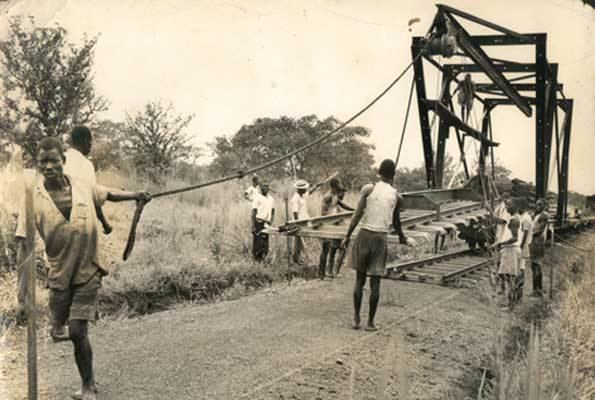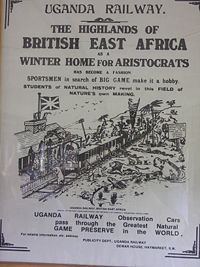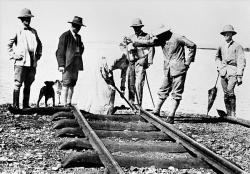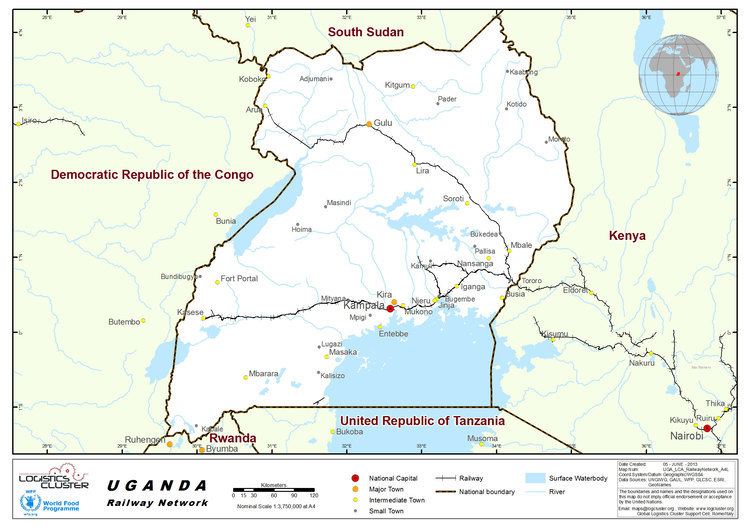 | ||
Uganda railways corporation receives shs1bn to revamp kampala s passenger train service
The Uganda Railway, colloquially known as the Lunatic Express or the Lunatic Line, is a railway system and former railway company dating to the colonial period. The line links the interiors of Uganda and Kenya with the Indian Ocean at Mombasa in Kenya.
Contents
- Uganda railways corporation receives shs1bn to revamp kampala s passenger train service
- Parliament puts uganda railway corporation on the spot over illegal lease of railway land
- Origins
- Lunatic Express
- Kedong Massacre
- The Tsavo Incident
- Extensions and branches
- Lake Victoria
- Lake Kyoga Lake Albert and the Nile
- The Railway and tourism
- Current usage
- Kenya
- Uganda
- Books and movies
- References

Parliament puts uganda railway corporation on the spot over illegal lease of railway land
Origins

Built during the Scramble for Africa, the Uganda Railway was the one genuinely strategic railway to be constructed in tropical Africa at that time. 2,498 workers died during its construction.

The Uganda Railway was named after its ultimate destination, for its entire original 660-mile length actually lay in what would become Kenya. Construction began at the port city of Mombasa in British East Africa in 1896 and finished at the line's terminus, Kisumu, on the eastern shore of Lake Victoria, in 1901. 200,000 individual 9-metre (30 ft) rail-lengths and 1.2 million sleepers, 200,000 fish-plates, 400,000 fish-bolts and 4.8 million steel keys including steel girders for viaducts and causeways had to be imported, necessitating the creation of a modern port at Kilindini Harbour in Mombasa. With their new steam-powered access to Uganda, the British could transport people and soldiers to ensure their domination of the region.

Before the railway's construction, the British East Africa Company had begun the Mackinnon-Sclater road, a 600 miles (970 km) ox-cart track from Mombasa to Busia in Kenya, in 1890.
The railway is 1,000 mm (3 ft 3 3⁄8 in) gauge and virtually all single-track.

Construction was carried out principally by labourers from British India, 32,000 of whom were brought in because of a lack of indigenous labour. While most of the surviving Indians returned home, 6,724 decided to remain after the line's completion, creating a community of Indian East Africans.
The railway was a huge logistical achievement and became strategically and economically vital for both Uganda and Kenya. It helped to suppress slavery, by removing the need for humans in the transport of goods.
A railway siding connecting to the residence of the High Commissioner to Uganda was used by Governor Frederick John Jackson and his 1910 BSA railcar that was used for his hunting parties. The railcar was recently restored in South Africa. The Governor lent his railcar to President Theodore Roosevelt on his visit to Uganda during the Smithsonian–Roosevelt African Expedition; a trip along the railway is chronicled in Roosevelt's book African Game Trails.
Lunatic Express
The term Lunatic Express was coined by Charles Miller in his 1971 The Lunatic Express: An Entertainment in Imperialism. The term The Iron Snake comes from an old Kikuyu prophecy: "An iron snake will cross from the lake of salt to the lands of the Great Lake…"
Political resistance to this "gigantic folly", as Henry Labouchère called it, surfaced immediately. Such arguments along with the claim that it would be a waste of taxpayers' money were easily dismissed by the Conservatives. Years before, Joseph Chamberlain had proclaimed that, if Britain were to step away from its "manifest destiny", it would by default leave it to other nations to take up the work that it would have been seen as "too weak, too poor, and too cowardly" to have done itself. Its cost has been estimated by one source at £3 million in 1894 money, which is more than £170 million in 2005 money, and £5.5 million or £650 million in 2016 money by another source.
Because of the wooden trestle bridges, enormous chasms, prohibitive cost, hostile tribes, men infected by the hundreds by diseases, and man-eating lions pulling railway workers out of carriages at night, the name "Lunatic Line" certainly seemed to fit. Winston Churchill, who regarded it "a brilliant conception", said of the project: "The British art of 'muddling through' is here seen in one of its finest expositions. Through everything—through the forests, through the ravines, through troops of marauding lions, through famine, through war, through five years of excoriating Parliamentary debate, muddled and marched the railway."
Kedong Massacre
Building the railway met local resistance on various occasions. A major incident was the Kedong Massacre, when the Maasai attacked a railway worker's caravan killing around 500 people because two Maasai girls had been raped. Englishman Andrew Dick led a counter-attack against them, but ran out of ammunition and was speared to death by the Maasai.
At the turn of the 20th century, the railway construction was disturbed by the resistance by Nandi people led by Koitalel Arap Samoei. He was killed in 1905 by Richard Meinertzhagen, finally ending the Nandi resistance.
The Tsavo Incident
The incidents for which the building of the railway may be most noted are the killings of a number of construction workers in 1898, during the building of a bridge across the Tsavo River. Hunting mainly at night, a pair of maneless male lions stalked and killed at least 28 Indian and African workers – although some accounts put the number of victims as high as 135.
Extensions and branches
Disassembled ferries were shipped from Scotland by sea to Mombasa and then by rail to Kisumu where they were reassembled and provided a service to Port Bell and, later, other ports on Lake Victoria (see section below). An 11-kilometre (7 mi) rail line between Port Bell and Kampala was the final link in the chain providing efficient transport between the Ugandan capital and the open sea at Mombasa, more than 1,400 km (900 mi) away.
Branch lines were built to Thika in 1913, Lake Magadi in 1915, Kitale in 1926, Naro Moro in 1927 and from Tororo to Soroti in 1929. In 1929 the Uganda Railway became Kenya and Uganda Railways and Harbours (KURH), which in 1931 completed a branch line to Mount Kenya and extended the main line from Nakuru to Kampala in Uganda. In 1948 KURH became part of the East African Railways Corporation, which added the line from Kampala to Kasese in western Uganda in 1956. and extended to it to Arua near the border with Zaïre in 1964.
Lake Victoria
Almost from its inception the Uganda Railway developed shipping services on Lake Victoria. In 1898 it launched the 110 ton SS William Mackinnon at Kisumu, having assembled the vessel from a "knock down" kit supplied by Bow, McLachlan and Company of Paisley in Scotland. A succession of further Bow, McLachlan & Co. "knock down" kits followed. The 662 ton sister ships SS Winifred and SS Sybil (1902 and 1903), the 1,134 ton SS Clement Hill (1907) and the 1,300 ton sister ships SS Rusinga and SS Usoga (1914 and 1915) were combined passenger and cargo ferries. The 812 ton SS Nyanza (launched after Clement Hill) was purely a cargo ship. The 228 ton SS Kavirondo launched in 1913 was a tugboat. Two more tugboats from Bow, McLachlan were added in 1925: SS Buganda and SS Buvuma.
Lake Kyoga, Lake Albert and the Nile
The company extended its steamer service with a route across Lake Kyoga and down the Victoria Nile to Pakwach at the head of the Albert Nile. Its Lake Victoria ships were unsuitable for river work so it introduced the stern wheel paddle steamers PS Speke (1910) and PS Stanley (1913) for the new service. In the 1920s the company added PS Grant (1925) and the side wheel paddle steamer PS Lugard (1927).
The Railway and tourism
As the only modern means of transport from the East African coast to the higher plateaus of the interior, a ride on the Uganda Railway became an essential overture to the safari adventures which grew in popularity in the first two decades of the 20th century. As a result, it usually featured prominently in the accounts written by travelers in British East Africa. The rail journey stirred many a romantic passage, like this one from former U.S. President Theodore Roosevelt, who rode the line to start his world-famous safari in 1909:
Passengers were invited to ride a platform on the front of the locomotive (pictured at right) from which they might see the passing game herds more closely. During Roosevelt's journey, he claimed that "on this, except at mealtime, I spent most of the hours of daylight."
Current usage
Parts of the railway remain in use today.
Kenya
The Kenya Railways Corporation runs passenger trains between Mombasa and Nairobi. In summer 2016 a reporter from The Economist magazine took the Lunatic Express from Nairobi to Mombasa. He wrote in his article that the railway was in a poor state, few Kenyans used it (there were no more than 50 on the train), it was seven hours late in starting and it took 24 hours for the journey. At the time it was hoped that the new Mombasa–Nairobi Standard Gauge Railway which was being constructed with Chinese assistance would be much better and would achieve the same journey in three to four hours.
The line between Nairobi and Kisumu near the Kenya–Uganda border has been closed since 2012.
In 2016 the Mombasa-Nairobi Standard Gauge Railway was under construction by the China Road and Bridge Corporation. It was planned to replace the metre gauge line and be completed in July 2017 with trains carrying 25 million tons of goods per year and travelling at 120 kilometres per hour and to cost US$13.8 billion. This stretch of railway was planned to be the first part of an ambitious East African Railway Master Plan that was projected to link Kenya with Uganda, South Sudan, Rwanda and Burundi.
Uganda
The URC was the joint recipient of the 2001 Worldaware Business Award for "assisting economic and social development through the provision of appropriate, sustainable and environmentally complementary transport infrastructure". The Uganda Railways Update Report gives details of management improvement.
Books and movies
Man-eating lions at Tsavo during the construction of the Uganda Railway feature in books:
Movies:
Books:
